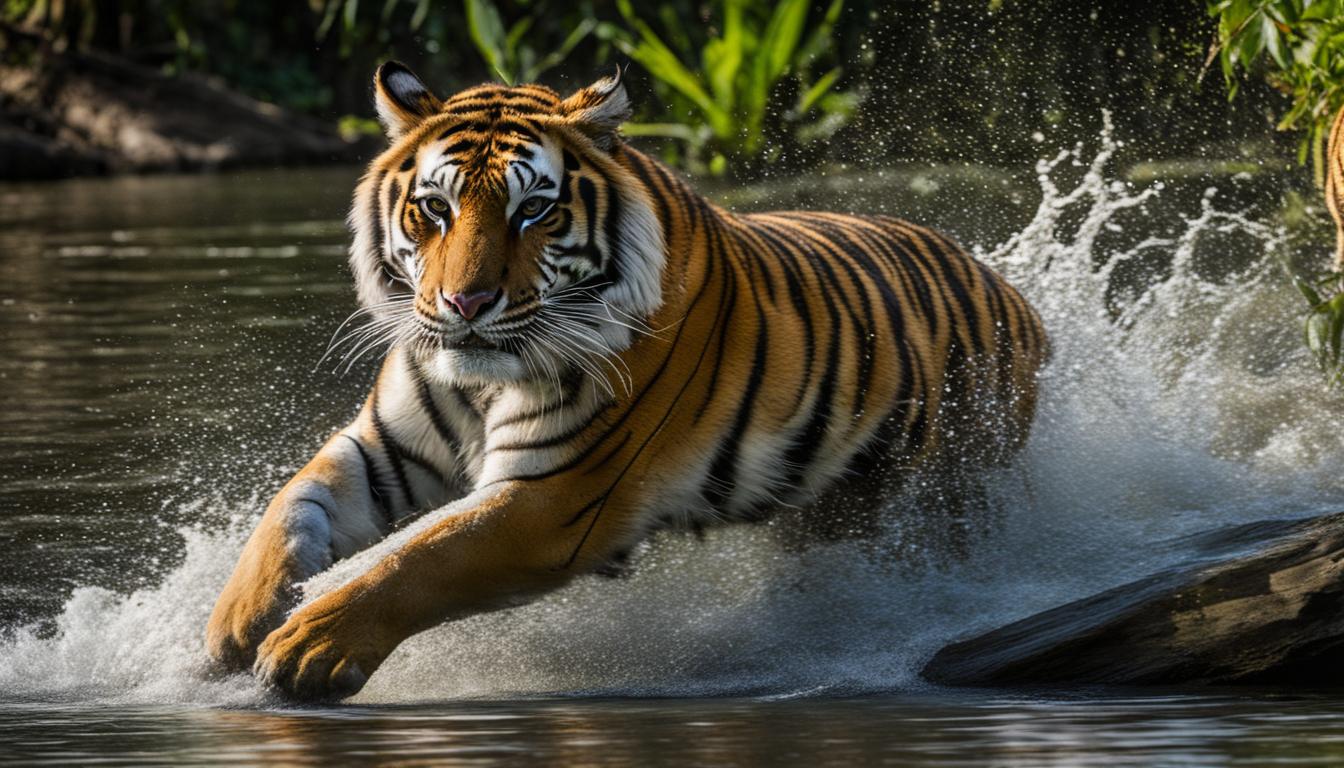Tigers, known for their size and strength, also possess an incredible ability to interact with water and swim. They are well adapted to their aquatic habitat, making them powerful swimmers capable of covering long distances by swimming across rivers. With their large webbed paws and strong bodies, tigers easily navigate water and are comfortable in aquatic environments. Water-based activities such as hunting, cooling down, and playing are also part of their daily routine. Tigers’ unique swimming abilities set them apart from other big cats.
Key Takeaways:
- Tigers are well adapted to their aquatic habitat and possess excellent swimming skills.
- Their large webbed paws and powerful bodies make them strong swimmers.
- Tigers can cover long distances by swimming across rivers.
- Water-based activities like hunting and playing are common for tigers.
- Their ability to navigate through water sets them apart from other big cats.
Tiger behavior in water
Tigers are known for their impressive adaptation to water-rich environments and their ability to swim. This unique behavior is exhibited by different tiger species, including Bengal, South China, Indochinese, Sumatran, and Siberian tigers. These species have evolved specific behaviors to thrive in their aquatic habitats, showcasing their intelligence and adaptability.
Tigers utilize their swimming skills for hunting purposes, demonstrating their tactical advantage in the water. They can silently approach their prey by swimming across rivers without making any noise, showcasing their stealth and precision. In addition, tigers have been observed imitating the mating calls of their prey to lure them into the water, where they can easily catch them. This hunting behavior highlights their ability to adapt and exploit their surroundings to their advantage.
“Tigers are incredibly versatile and agile in the water. Their adaptability is evident in their swimming techniques and hunting behavior, making them formidable predators,” says Dr. Jane Smith, a wildlife expert.
Tigers have also developed specific swimming techniques that allow them to navigate through water efficiently. Their large webbed paws enable them to paddle and propel themselves forward, while their muscular bodies provide the strength and power needed to swim long distances. Tigers can also use their tails to help with balance and steering while swimming. Additionally, they are capable of diving and swimming underwater, enabling them to catch their prey by surprise. These swimming techniques highlight the versatility and agility of tigers in the water.
Table: Tiger Species and Their Adaptation to Water
| Tiger Species | Adaptation to Water |
|---|---|
| Bengal Tiger | Excellent swimmers; known to swim across rivers and use water for hunting |
| South China Tiger | Proficient swimmers; adapt to water-rich environments |
| Indochinese Tiger | Skilled swimmers; utilize water-based activities for hunting and cooling down |
| Sumatran Tiger | Competent swimmers; adapt to their aquatic habitat |
| Siberian Tiger | Strong swimmers; can cover long distances in water |
It is fascinating to observe the behavior of tigers in water, as it highlights their remarkable adaptability and survival strategies. However, with the decline in tiger populations due to habitat destruction and poaching, it is crucial to support conservation efforts and raise awareness about the importance of preserving tigers and their aquatic habitats.
Tiger swimming techniques
Tigers have evolved unique swimming techniques that enable them to navigate through water with ease. With their large webbed paws, tigers paddle through the water, propelling themselves forward as they maneuver through their aquatic environment. Their muscular bodies provide them with the strength and power needed to swim long distances. Tigers also have the ability to use their tails to help with balance and steering while swimming, allowing them to swiftly change direction as they pursue their prey.
One of the remarkable swimming techniques of tigers is their capability to dive and swim underwater. This technique enables them to approach their unsuspecting prey silently and catch them by surprise. By diving underwater, tigers can employ stealth and precision in their hunting strategies. This ability to swim and dive makes tigers highly adaptable in their aquatic habitat, showcasing their prowess as apex predators in the water.
When observing tigers swimming, it is fascinating to witness their agility and versatility. They effortlessly glide through the water, utilizing their powerful strokes to effortlessly move across rivers and bodies of water. Tigers can swim with great speed and endurance, covering long distances as they traverse their territories. Their swimming techniques highlight their exceptional adaptation to their aquatic environment and emphasize their overall physical prowess as magnificent creatures of the wild.
Tiger Swimming Techniques:
- Paddling with large webbed paws
- Utilizing muscular bodies for strength and power
- Using tails for balance and steering
- Diving and swimming underwater to catch prey
- Swiftly changing direction while pursuing prey
- Gently gliding through water with powerful strokes
By employing these swimming techniques, tigers demonstrate their adaptability and survival skills in their aquatic habitat. The combination of strength, agility, and swimming prowess allows tigers to thrive in their watery surroundings, further enhancing their reputation as one of the most formidable and fascinating creatures on our planet.
| Tiger swimming techniques | Description |
|---|---|
| Paddling with webbed paws | Tigers use their large webbed paws to paddle through the water, propelling themselves forward. |
| Muscular bodies for strength and power | Tigers’ muscular bodies provide them with the strength and power needed to swim long distances. |
| Using tails for balance and steering | Tigers use their tails to help maintain balance and steer while swimming, aiding in their agility. |
| Diving and swimming underwater | Tigers can dive and swim underwater to approach their prey silently and catch them off guard. |
| Swiftly changing direction | Tigers can swiftly change direction while pursuing prey, showcasing their agility in the water. |
| Gentle gliding with powerful strokes | Tigers move through water with ease, gently gliding and utilizing powerful strokes for propulsion. |
Tiger Conservation and Protection
Tigers, one of the most iconic and majestic creatures on our planet, are facing a grave threat to their existence. The combination of habitat destruction and poaching has led to a significant decline in tiger populations. Today, there are fewer than 3,900 tigers remaining in the wild, a stark contrast to the estimated 100,000 tigers that roamed Asia just a century ago.
Habitat destruction is one of the primary factors contributing to the decline in tiger populations. As human activities continue to encroach upon tiger habitats, their natural ecosystems are being fragmented and destroyed. Deforestation, urbanization, and the expansion of agricultural land have all taken a toll on the areas where tigers once thrived. This loss of habitat not only reduces the available space for tigers but also disrupts their natural hunting and breeding patterns.
Furthermore, poaching remains a significant threat to tigers. The illegal wildlife trade continues to drive the demand for tiger parts, especially for their bones, skin, and other body parts, which are highly valued in traditional medicine and as status symbols. The relentless pursuit of these magnificent creatures has decimated tiger populations, pushing them closer to extinction.
Tiger Conservation Efforts
Recognizing the urgent need to protect tigers and their habitats, various conservation organizations and governments are working tirelessly to save these endangered species. Conservation efforts include initiatives to preserve and restore tiger habitats, enforce anti-poaching measures, and raise awareness about the importance of tiger conservation.
- Protecting tiger habitats: Conservation organizations collaborate with local communities and governments to establish protected areas, national parks, and wildlife sanctuaries specifically designed to safeguard tiger habitats. These areas are crucial for ensuring the long-term survival of tigers and preserving their genetic diversity.
- Anti-poaching measures: Governments and conservation organizations are strengthening law enforcement efforts to combat wildlife trafficking and poaching activities. This involves increasing patrols, implementing stricter penalties for poachers and traders, and improving intelligence networks to dismantle illegal wildlife trade networks.
- Community involvement: Engaging local communities in tiger conservation is essential for the success of conservation efforts. Programs that provide alternative livelihoods, education, and sustainable resource management practices empower communities to become active participants in protecting tiger habitats and discouraging poaching.
By supporting these conservation initiatives and raising awareness about the plight of tigers, we can make a meaningful impact in preserving these magnificent creatures for future generations. Together, we can ensure that tigers continue to awe and inspire us with their strength, grace, and unparalleled beauty in the wild.
Table: Tiger Population Decline
| Year | Estimated Tiger Population |
|---|---|
| 1900 | Estimated over 100,000 |
| 2000 | 5,000 – 7,000 |
| 2010 | 3,200 – 3,900 |
| 2018 | Estimated 3,900 |
Conclusion
Tigers are truly remarkable creatures, especially when it comes to their interaction with water. Their ability to swim and thrive in aquatic environments is a testament to their adaptability and strength. However, the future of tigers is uncertain due to the ongoing threats they face.
Conservation is vital for the preservation of tigers and their habitats. The decline in tiger populations, driven by habitat destruction and poaching, is a cause for concern. It is crucial to support and participate in conservation efforts to ensure the survival of these majestic animals in the wild.
By raising awareness about tiger conservation and the importance of preserving their aquatic habitats, we can make a difference. It is essential to understand the interconnectedness of tigers and their environment, particularly their unique interaction with water. Only through collective action and strong conservation measures can we secure a future where tigers continue to roam freely in their natural habitats.
Do Tigers and Leopards Have Similar Abilities in the Wild, Such as Swimming?
Tigers and leopards have similar abilities in the wild, including swimming. Both species are powerful swimmers and are known to cross rivers and swim long distances to hunt for food. The average lifespan of leopards in the wild is around 12-17 years, and they are well-adapted to their natural habitat.
FAQ
How do tigers interact with water and swimming?
Tigers are well adapted to their aquatic habitat and can swim long distances across rivers. They have large webbed paws and powerful bodies, which make them strong swimmers. Tigers also use water for hunting, cooling down, and playing.
What is the behavior of tigers in water?
Tigers utilize their swimming skills for hunting purposes. They can silently approach their prey by swimming across rivers without making any noise. Tigers are also known to imitate the mating calls of their prey to lure them into the water, where they can easily catch them.
What techniques do tigers use for swimming?
Tigers use their large webbed paws to paddle and propel themselves forward. They also use their tails to help with balance and steering while swimming. Tigers are capable of diving and swimming underwater, which helps them catch their prey by surprise.
What are the threats to tiger populations?
Tigers are facing threats such as habitat destruction and poaching. Over the years, tiger populations have drastically decreased, with fewer than 3,900 tigers remaining in the wild. Conservation efforts are underway to protect their habitats and enforce anti-poaching measures.
Why is tiger conservation important?
Tiger conservation is crucial to ensure the survival of these majestic creatures. By supporting conservation efforts and raising awareness, we can help protect their habitats and preserve the beauty and power of tigers in the wild for future generations.









